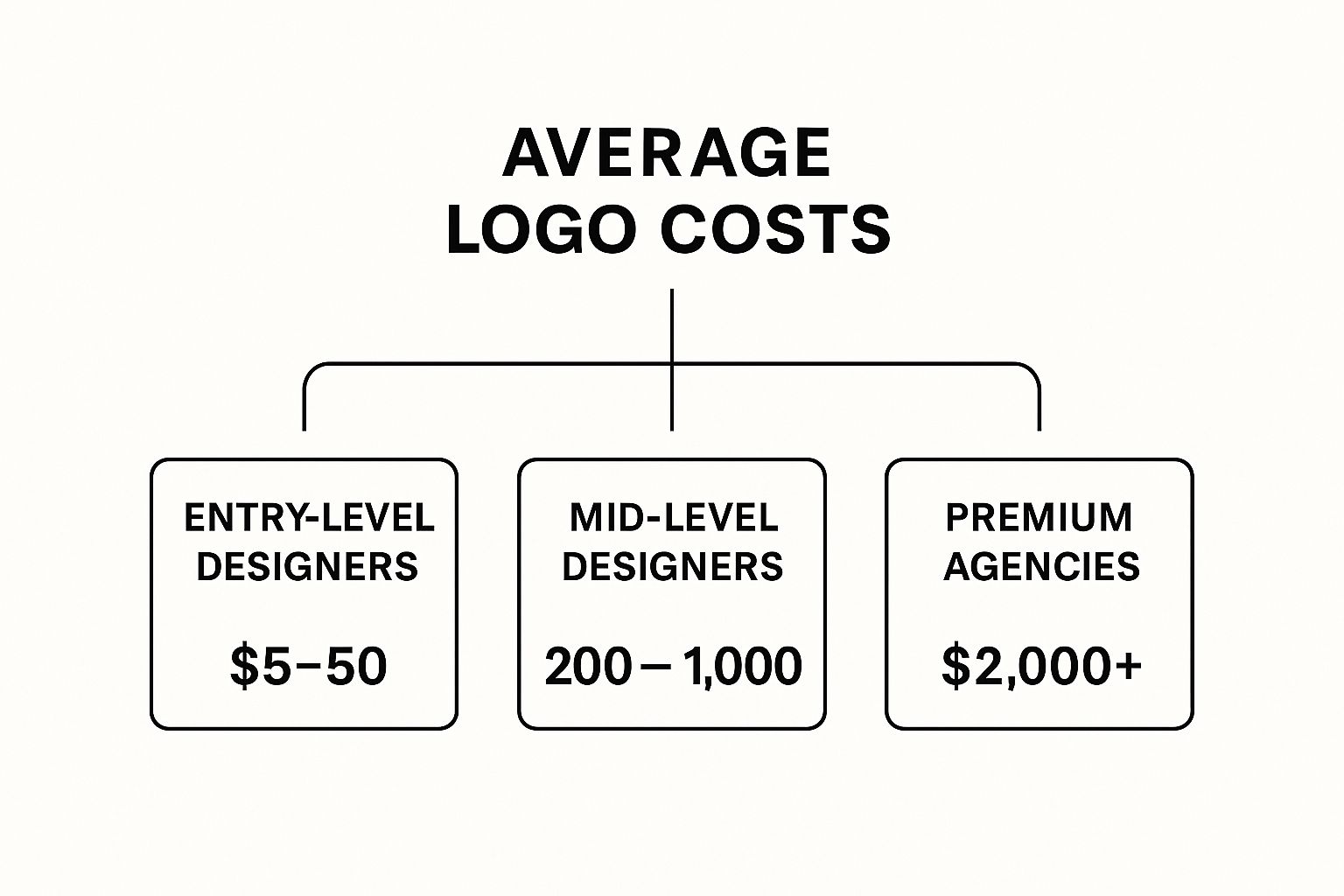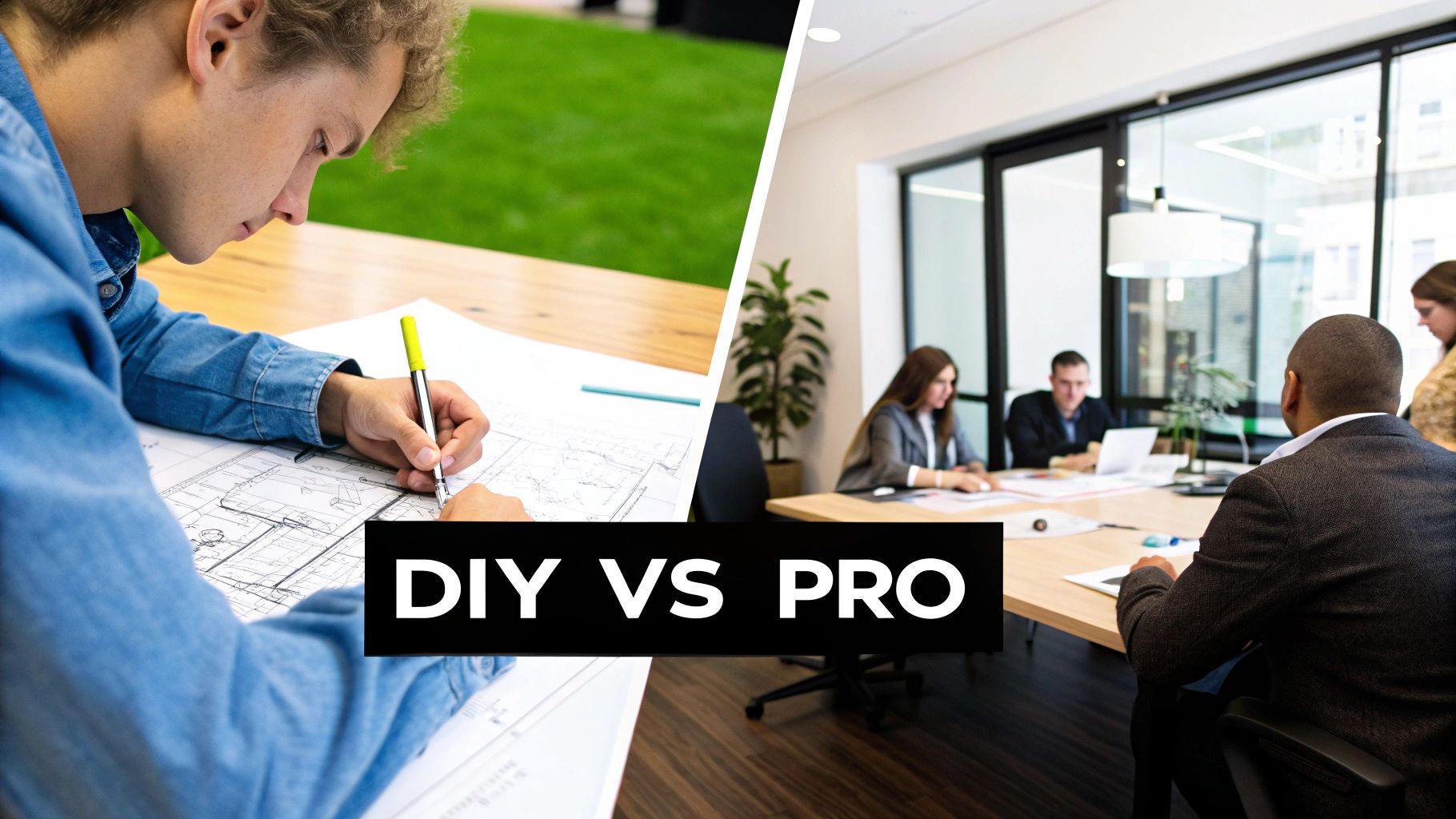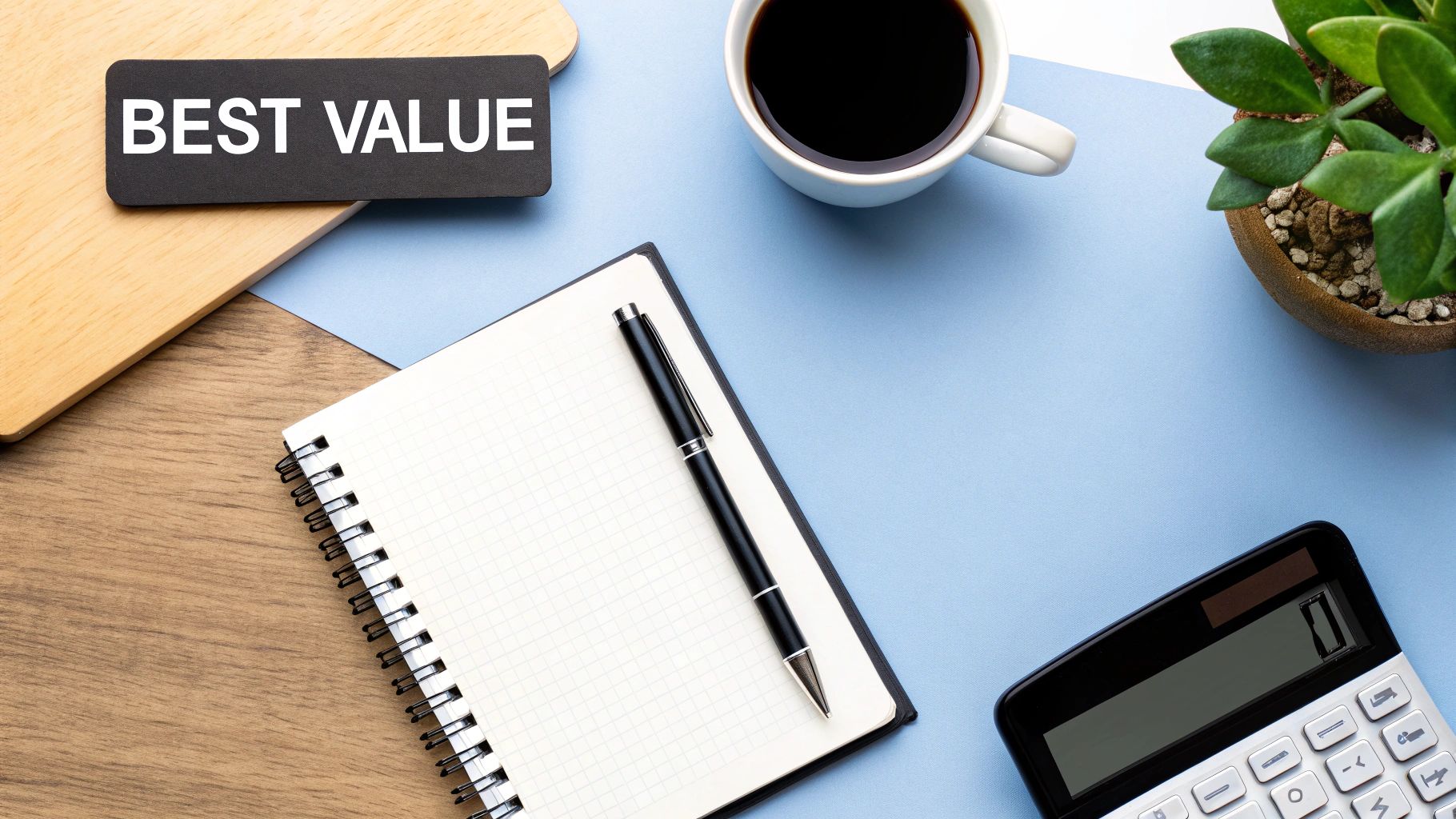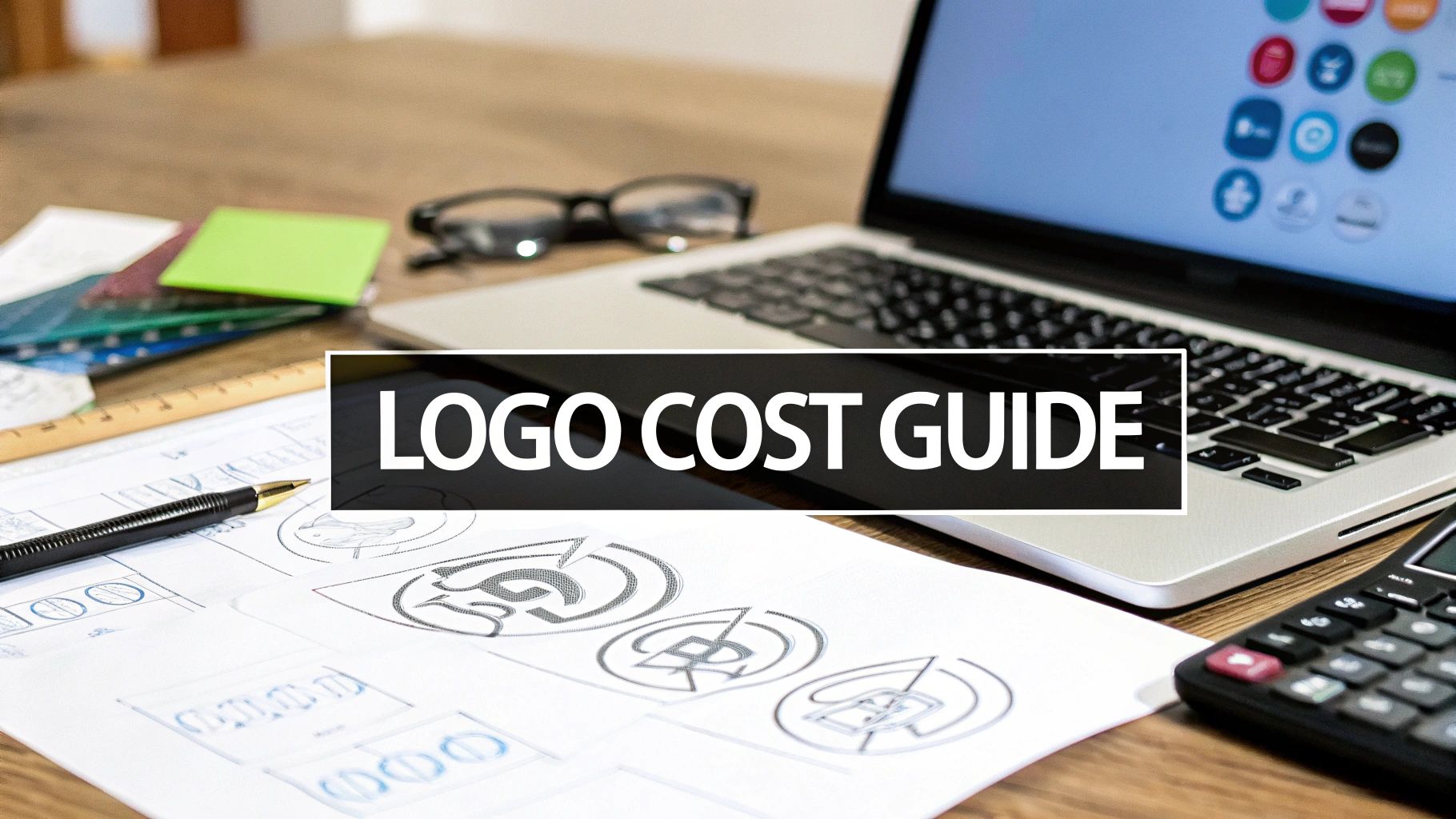So, how much does a logo really cost? It’s a question with a surprisingly wide answer: anywhere from $0 to well over $50,000. The final price tag boils down to who you hire, how complex the design is, and the amount of strategic thinking behind it.
Your Quick Guide To Logo Design Costs
Thinking about the price of a logo is a lot like shopping for a car. You could grab a simple scooter for a few hundred bucks to zip around town—it works and gets the job done for basic needs. Or, you could invest in a custom-built, heavy-duty truck designed for serious performance. Both are vehicles, but they solve very different problems and come with very different price tags.
A logo is so much more than a pretty picture; it's a hard-working business asset. It's the face of your brand, the first impression you make, and a symbol of your company's personality and promise. Because of this, the cost isn't just for the final artwork. You're paying for the designer's experience, the research into your market, the creative process, the back-and-forth on revisions, and the legal rights to own and use that design.
Comparing Costs By Provider
To figure out where your budget might land, it helps to look at the different options out there. The cost of a logo can swing wildly depending on who you hire, with prices starting at free for DIY tools and soaring to $50,000+ for top-tier agencies.
This massive range exists because you're buying different levels of service, from a simple template to a complete brand identity system. A small business just starting out might get exactly what they need from a talented freelancer, while a large corporation will require the deep strategic dive that only a branding agency can provide. For a closer look at what drives these costs, check out our in-depth article on logo design pricing.
Every business has different needs. A brand new Etsy shop might just need a clean, simple mark to get started. On the other hand, a tech startup chasing venture capital needs a thoroughly researched identity that connects with both investors and future customers. You can find more insights on these pricing tiers over at The Web Factory.
To make this easier to digest, here's a table that breaks down what you can generally expect to pay with different types of providers.
Logo Design Cost At A Glance By Provider
This table shows a quick comparison of logo design costs across different types of providers, from DIY tools to professional agencies, helping you see where your budget fits.
Provider TypeTypical Price RangeBest ForWhat You GetDIY Logo Makers$0 – $100Hobbyists or businesses needing a quick, temporary solution.A basic, template-based logo with limited customization and no strategic input.Freelancers$300 – $1,500Startups and small businesses needing a custom and professional look.A unique, custom-designed logo with some strategic thought and multiple file formats.Design Studios$1,500 – $5,000Mid-sized businesses that need a polished brand presence.A professionally crafted logo with more strategic input and branding elements.Branding Agencies$5,000 – $50,000+Established companies or major rebranding projects.A comprehensive brand identity system, including deep research, strategy, and extensive assets.
As you can see, what you pay directly relates to the level of expertise and the depth of the work involved. Choosing the right path depends entirely on your business goals and where you are in your journey.
Why Logo Design Prices Vary So Much

Have you ever looked at logo design quotes and felt a bit of whiplash? One might come in at $50, while the next one soars past $5,000. It’s a huge gap that can feel confusing, but it all starts to make sense once you understand what you're actually paying for.
The real difference isn’t just the final image—it's the depth of the process behind it.
Think of it like buying a vehicle. You could get a $100 scooter that gets you from A to B. It’s functional, sure, but you wouldn’t use it to haul commercial goods across the country or build a logistics empire. For that, you’d need a custom-engineered truck with a powerful engine and a reinforced frame. A much bigger investment for a much bigger job.
A cheap logo is that scooter. It fills an immediate, basic need. A professionally designed logo is the truck—an asset engineered to be a powerful, long-lasting workhorse that drives your business forward.
The Hidden Value Drivers
So, when you ask "how much does a logo cost?" what you're really asking about is the value of the service, not just the file you download. A higher price tag almost always reflects a deeper investment in the key areas that produce an effective and durable brand identity. The cost is tied directly to the time, expertise, and strategic thinking a designer or agency puts into your project.
These are the things that separate a simple graphic from a strategic business tool.
- Strategic Process: A low-cost logo usually skips the strategy. A professional process, on the other hand, starts with a deep dive into your business, your customers, and your long-term goals. This involves research, mood boarding, and crafting a solid design brief that guides every creative decision.
- Market and Competitor Research: A designer can't create a logo that helps you stand out if they don’t know what you need to stand out from. A big chunk of the cost covers analyzing your competitors' branding to find gaps and opportunities for you to differentiate yourself.
- Experience and Expertise: You’re paying for a designer's years of experience, their grasp of timeless design principles, and their skill in translating business goals into a visual language. A seasoned pro knows how to create something that lasts, steering clear of fleeting trends that will look dated in a year.
The investment for corporate identity logos typically spans from a few hundred dollars to over $5,000 depending on design complexity and the creator’s expertise. Simple, minimalist logos cost on average between $100 and $1,000, reflecting straightforward designs with clean typography suitable for many businesses seeking clarity and recognizability.
This spectrum shows that as the project gets more complex and the need for expert guidance grows, so does the price. More detailed logos with custom typography, for instance, can easily push costs past $2,000. On the flip side, pre-made templates might only set you back $50, but they offer zero uniqueness.
Revisions and Collaboration
The revision process is another huge factor in the final cost. A cheap design service might offer you one or two revisions—or none at all. You’re then stuck accepting something that isn’t quite right or paying extra for every little change.
A professional design package, however, builds collaboration right into the price. It assumes there will be a healthy back-and-forth to refine concepts until the final logo is perfect. This iterative process is essential for landing on a design you truly love and that actually works for your business.
Ownership and Deliverables
Finally, a massive part of what you’re paying for is what you get at the end of the project. The single most important deliverable is the transfer of intellectual property (IP) rights. When you pay for a professional logo, you should receive full ownership, period. This allows you to trademark it and use it however you want, without restrictions.
Beyond just ownership, you're also paying for a complete toolkit of files. A pro will provide your logo in every format you could possibly need:
- Vector Files (AI, EPS, SVG): These are the holy grail. They are infinitely scalable, meaning your logo will look just as crisp on a tiny pen as it will on a massive billboard.
- Raster Files (PNG, JPG): These are pixel-based files perfectly suited for web and digital use, like on your website or social media profiles.
- Color Variations: You'll get your logo in full color, black, and white to make sure it looks great on any background.
Understanding these factors makes it clear that a higher logo design price isn't arbitrary. It’s a direct reflection of a more thorough, strategic, and legally sound process. This is fundamental to understanding why logo design is important as a core business investment.
A Deep Dive Into Your Logo Design Options
Figuring out how much a logo should cost really comes down to what you're getting for your money. It’s not just about the final image file. It's about the thinking, the creativity, and the strategic work that goes into it.
Let's walk through the main ways you can get a logo, from a quick do-it-yourself job to a full-blown partnership with a creative agency. Each path has its own trade-offs between price, speed, and originality, so the "right" choice really depends on where your business is at right now.
Option 1: DIY Logo Makers
Think of DIY logo makers as online vending machines for logos. You pop in your company name, pick an industry, and out come dozens of designs built from a library of pre-made icons and fonts.
- Pros: They’re incredibly fast and cheap, often costing less than $100. You have total control and can get something in minutes.
- Cons: The huge downside is that you get zero originality. Because these tools recycle the same elements, your logo could look bland or, worse, just like someone else's. There’s no strategy involved—it’s just decoration.
- Best For: Hobbyists, brand-new startups with absolutely no budget, or anyone who just needs a temporary placeholder while they figure things out.
Option 2: Freelance Marketplaces
Platforms like Fiverr and Upwork are massive digital flea markets for designers. You can find someone to create a logo for as little as $5 or a few hundred for something more refined. You just have to be willing to do some digging.

The sheer number of options can be overwhelming, and while there are hidden gems, quality varies wildly. Vetting designers is on you.
- Pros: You have a massive variety of styles and price points to choose from. The competition on these sites can keep prices low.
- Cons: It's a real mixed bag. You might deal with communication barriers or get a low-quality result. It’s your job to write a killer brief and manage the project from start to finish.
- Best For: Small businesses and startups who need a custom logo on a tight budget and have the time to hunt for the right person.
Option 3: Independent Freelancers
When you hire a freelance designer directly, you’re usually getting a more experienced creative partner. These are pros with their own portfolios and a proper process. They’ll want to talk to you, understand your vision, create mood boards, and offer a set number of revisions.
A great freelance designer doesn't just make pretty pictures. They become a creative partner, helping you turn your business goals into a visual identity that actually works.
Expect to invest more here. A good independent freelancer typically starts around $300 and can easily go up to $2,500 or more, depending on their skill and the project's complexity.
- Pros: You get a truly one-of-a-kind logo and a direct, one-on-one relationship with the designer. The approach is far more strategic than the cheaper options.
- Cons: It's a bigger commitment of both time and money. You’ll need to do your homework to find someone you click with.
- Best For: Businesses ready to invest in a strong brand foundation and want a professional, unique logo without paying agency prices.
Option 4: Branding Agencies
Working with an agency is the whole nine yards. They don’t just design a logo; they build your entire brand identity from the ground up. This is a deep, strategic process involving market research, competitor analysis, and workshops to nail down your core message.
This top-tier service comes with a top-tier price tag. An agency project often starts at $5,000 and can climb to $20,000 or more for a comprehensive branding package.
The numbers bear this out. Research shows that about 65% of small businesses aim to spend up to $500 on a logo, which makes sense for their scale. In contrast, only 15% are ready to invest over $1,000—these are typically the larger companies that hire agencies for this level of strategic work. You can see more data on logo cost trends to understand how business goals influence spending.
- Pros: You get an incredibly high-quality, research-backed brand identity that includes everything from the logo to colors, fonts, and detailed guidelines. It's a serious long-term asset.
- Cons: The cost puts it out of reach for most small businesses. The process is also much longer and more intensive.
- Best For: Established companies, well-funded startups, or any business undergoing a major rebrand that needs a complete, data-driven identity system.
What Your Budget Gets You: A Feature Comparison
To make sense of these options, it helps to see what you actually get at each price point. A $50 logo and a $5,000 logo are two completely different products, involving different processes and deliverables.
This table breaks down the features you can typically expect.
Feature/DeliverableDIY ($0 - $100)Freelancer ($300 - $1,500)Agency ($5,000+)OriginalityLow (Template-based)High (Custom-made)Highest (Research-backed)Strategy & ResearchNoneBasic to moderateExtensive & in-depthRevision RoundsLimited or noneUsually 2-3 roundsMultiple, collaborative roundsFile FormatsBasic (PNG, JPG)Professional (Vector, source files)Full suite for all applicationsBrand GuidelinesNoBasic style guide (optional)Comprehensive brand bookTurnaround TimeMinutes to hoursDays to weeksWeeks to monthsCreative PartnershipNone (Self-service)One-on-one relationshipFull team collaboration
Ultimately, choosing the right path is about aligning your budget with your ambition. A simple, low-cost logo might be all you need to get started, while a deeper investment can set the foundation for your brand for years to come.
What You Are Actually Paying For

When you hire a professional for a logo, you’re not just buying a pretty picture. You're investing in a complete branding toolkit. The price tag reflects all the crucial assets you get, which are designed to make your brand look sharp and consistent everywhere.
Think of it this way: you're not just getting a snapshot of a house, you're getting the full set of architectural blueprints. A picture is nice, but the blueprints let you build, expand, and make sure everything is up to code. A proper logo package is your brand's blueprint.
Understanding these deliverables is the key to figuring out logo costs. It’s what separates a cheap, throwaway graphic from a genuine business asset. Knowing what you're paying for ensures you walk away with everything you need for the long haul.
The Non-Negotiable Vector Files
The single most important part of any professional logo delivery is the vector file. This is the master, original file of your logo, usually in a format like AI (Adobe Illustrator), EPS, or SVG.
Unlike standard images like JPEGs, which are made of tiny pixels, vector files are built with math. That sounds complicated, but it just means they can be scaled to any size imaginable—from the side of a pen to a giant billboard—without ever getting blurry or pixelated.
Without these files, you're stuck. A good designer knows this and will always provide them. They are the source code of your brand's identity, essential for any serious printing or manufacturing job.
Your Everyday Digital Files
Along with the master vector files, you’ll also get a set of raster files. These are your workhorse files for all things digital. They’re pixel-based and ready to go for your website, social media, email signature, or online ads.
You'll typically get two key types:
- PNG (Portable Network Graphics): This is your best friend for web use. Why? Because it supports a transparent background. That means you can place your logo over a colored background or a photo without that ugly white box appearing around it.
- JPG (Joint Photographic Experts Group): These are great for photos but less ideal for logos since they don't do transparency. Still, they have their uses in certain digital spots.
Having both ensures your logo looks crisp and clean wherever it shows up online. This combination of vector and raster files gives you the flexibility to handle any marketing task that comes your way. To see how these files are created, check out our guide on the complete logo design process.
Color Variations and Brand Guidelines
A logo has to work everywhere, not just on a clean white page. A truly professional package includes different color versions to make sure your logo is always recognizable.
A great logo is adaptable. It should be just as recognizable in a single color on a promotional pen as it is in full color on your website's homepage.
At a minimum, you should receive your logo in these formats:
- Full Color: The primary, standard version.
- Black: A solid black version for one-color printing or placing on light backgrounds.
- White (Reversed): A solid white version that pops on dark or colorful backgrounds.
If you’re making a larger investment, you might also get a brand style guide. This is your brand's rulebook. It lays out your official colors (with codes like HEX, RGB, and CMYK), your brand fonts, and the do's and don'ts of using your logo. This document is priceless for keeping your brand consistent as your company grows. To get a better sense of how these deliverables impact cost, it's helpful to see how professional services structure their pricing.
How To Set A Realistic Logo Design Budget
Figuring out what to spend on your logo isn't about plucking a number out of thin air. It’s a real business decision that should match where your company is today and where you want it to go tomorrow. The best way to start is by changing the question from "How much does a logo cost?" to "What's the right investment for my specific goals?"
This really just starts with a bit of honest self-assessment. By thinking through a few key questions about your business, you can put the cost into perspective and land on a budget that actually makes sense for you. It’s the difference between simply spending money and strategically building a core asset for your brand.
Key Questions To Define Your Budget
Before you can set a budget, you have to know what you really need. The perfect logo budget for a solo founder testing an idea is worlds away from what an established company needs for a full rebrand.
Get started by asking yourself these critical questions:
- What stage is my business in? A brand-new startup running on fumes has very different priorities than a profitable, growing business. Early on, you might need to be lean, while a more established company can and should invest more for a strategic identity.
- How critical is a great visual brand in my industry? For some industries—like fashion, restaurants, or tech gadgets—a powerful visual identity is make-or-break from day one. In other spaces, especially B2B, a clean and professional logo might be all you need to get going.
- What does my competition look like? Honestly, go look at your main competitors. If they all have sharp, professional branding, a cheap or generic logo will instantly make your business look less credible by comparison.
- What are my long-term plans for this logo? Is this just a "good enough for now" fix, or are you looking for a timeless mark that will define your brand for the next ten years? A long-term asset always justifies a bigger upfront investment.
A Simple Framework For Budgeting
Once you have a feel for these answers, you can start building a budget framework instead of just looking at random prices. It can be helpful to see how other creative fields estimate costs; for instance, an architecture design fee estimator shows how complex creative projects are priced based on scope and value. It’s a good reminder that professional design is a calculated investment, not just a line item.
A realistic budget is one where the cost of the logo is proportional to the value it's expected to bring to the business. It’s an investment in your brand’s future, not just an operational expense.
For example, a lean startup might set aside a small but dedicated slice of its initial funding for branding. This could be just enough to hire an experienced freelancer, falling somewhere in the $500 to $1,500 range.
On the other hand, an established company going through a rebrand should view the project as a major investment. They aren't just creating something new; they're undoing old brand recognition and building new equity. This kind of strategic work easily justifies an agency-level budget of $5,000+ to cover deep research, brand strategy, and a complete identity system.
By connecting your budget directly to your business goals, you move beyond the simple cost and start making a powerful, strategic decision for your brand's future.
Frequently Asked Questions About Logo Costs

As you figure out the best path for your brand, a few key questions about logo costs always seem to pop up. Getting straight answers helps you move forward with confidence, knowing you’re making a smart investment. Let's tackle some of the most common ones I hear from business owners.
Is Paying for a Logo Really Worth It?
Without a doubt. Think of it this way: a professional logo is the face of your business. It’s what helps you look credible, build trust, and stand out from the crowd.
While a DIY logo might get you started, a thoughtful, professionally designed logo is an investment that pays for itself over and over again through stronger brand recognition.
What If I Can’t Afford a Professional Logo Yet?
That’s a common hurdle, and you have options. Don't let a tight budget stop you from getting started.
A DIY logo maker can give you a clean, simple placeholder for now. Another route is to look for up-and-coming designers on freelance sites who are building their portfolios and often charge less. Just remember, this is a temporary fix. As your business grows, make it a priority to reinvest in a professional logo that truly represents your brand.
How Long Does the Design Process Take?
This really depends on the route you take. The timeline can vary dramatically.
Here’s a rough guide:
- DIY Logo Maker: You can have a basic logo in just a few minutes.
- Freelance Designer: This usually takes anywhere from a few days to a couple of weeks, factoring in their schedule and any revisions you request.
- Design Agency: Be prepared for a much more involved process. This can take several weeks or even a few months because it includes in-depth research, strategy, and brand workshops.
Should I Pay an Hourly Rate or a Flat Fee?
For logo design, I almost always recommend a flat project fee. It’s just cleaner. You know the final cost upfront, which makes budgeting a breeze. No surprise bills if the project takes a bit longer or needs more tweaks than expected.
An hourly rate can get messy and unpredictable. A flat fee keeps everyone focused on the same goal: creating a fantastic final logo, not just counting the hours it took to get there.
Ready for a logo that blends professional quality with incredible speed and value? At Softriver, we deliver custom-designed logos and full brand identities from top-tier talent in as little as 48 hours. Get the strategic, timeless design your business deserves without the agency price tag. Start your project with Softriver today!







